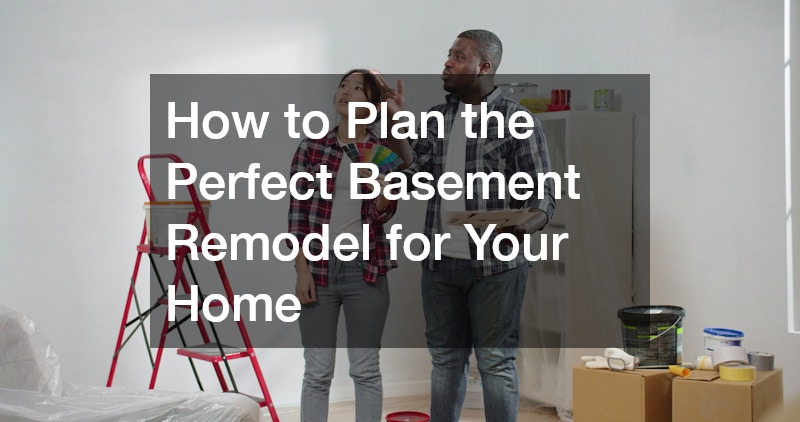A well-designed basement can transform an underutilized area into one of the most valuable and versatile spaces in a home. Whether your goal is to create a cozy family room, a home gym, an entertainment zone, or an additional guest suite, thoughtful planning ensures that every square foot contributes to comfort, functionality, and property value. A successful basement remodel requires a detailed understanding of design, structure, and practical logistics. From addressing moisture control to choosing finishes and integrating smart storage, the right approach combines creativity with precision. By carefully mapping out your design goals and addressing any foundational or structural concerns early, homeowners can turn a dim, unused basement into a bright, welcoming retreat that complements their lifestyle and enhances overall home equity.
Assessing the Space and Setting a Vision
Before beginning any basement remodel, homeowners should take time to thoroughly assess their space. This step sets the foundation for the entire project by identifying structural conditions, layout limitations, and possibilities for transformation. A proper inspection reveals details about ceiling height, existing insulation, plumbing routes, and potential sources of moisture or air leaks. By understanding these aspects early, you can design with clarity and prevent costly surprises down the road.
Start by defining the purpose of the remodeled basement. Will it serve as a family entertainment hub, a private home office, or an extra bedroom suite? The answer will guide every design decision—from flooring materials to lighting types. Functionality and aesthetics should work hand in hand. For instance, if the basement will double as a living area, focus on creating warmth and comfort through appropriate finishes and layout planning.
Lighting plays a crucial role in defining the atmosphere. Since basements often lack natural light, integrating recessed fixtures, LED strips, and strategically placed mirrors can make the space feel open and airy. You may also want to explore egress window installation for both natural light and safety compliance. Additionally, ventilation and humidity control are vital to maintaining a healthy environment. Even the most beautiful design will fall short if dampness or poor air quality becomes an issue.
Lastly, develop a realistic budget and timeline that includes contingencies for unexpected findings. Working with professionals can help ensure that your basement remodel aligns with local building codes and that every stage—from demolition to final inspection—is completed efficiently and safely.
Managing Waste and Donations During Renovation
When preparing for a renovation, managing debris and unwanted items efficiently is an essential part of keeping your project organized. Decluttering not only clears physical space but also creates a sense of mental order before the work begins. Items that no longer fit your home’s vision can be repurposed or donated local donation center. Many such organizations accept furniture, appliances, and building materials, helping to reduce waste and support community causes.
During demolition, you’ll generate materials such as drywall, old carpet, framing wood, and insulation. Instead of allowing debris to accumulate, consider a local dumpster rental to streamline cleanup. Having a dumpster on-site ensures that your renovation stays tidy, reduces hazards, and speeds up the process. Dumpster sizes vary, so choose one appropriate for your project scale—10-yard containers are often sufficient for small remodels, while larger bins handle full structural overhauls.
Additionally, trash and recycling pick up throughout the project. Separating recyclable materials like metal, cardboard, and glass not only supports sustainability but can also reduce disposal fees. Some municipalities even offer bulk pickup days for renovation waste, so checking local schedules may save time and money.
Keeping the worksite organized promotes efficiency and safety. Clear pathways prevent tripping hazards, while proper waste management helps ensure compliance with local building regulations. Whether you’re handling demolition yourself or hiring a crew, consistent disposal planning eliminates unnecessary stress and allows you to focus on the creative aspects of your basement remodel.
Addressing Structural Integrity and Moisture Issues
Before any construction begins, inspecting the foundation and structural framework is non-negotiable. The basement’s role as the lowest level of the home makes it particularly susceptible to water damage, leaks, and soil pressure. Identifying and repairing these issues early guarantees a more durable renovation. A professional contractor or structural engineer can evaluate load-bearing walls, floor joists, and insulation to ensure stability.
If you discover uneven flooring, damp spots, or musty odors, it may indicate hidden issues that need attention. Waterproofing solutions—such as installing vapor barriers, sump pumps, and perimeter drainage systems—can help safeguard your investment. When dealing with older homes, crawl space repairs are also worth considering. Addressing insulation and sealing in these smaller areas can reduce moisture migration and improve the home’s overall energy efficiency.
In some cases, foundation cracks or settling require specialized solutions like epoxy injections or underpinning. These measures protect against long-term structural damage and make the space safer for future use. Once the foundation is secure, it’s easier to proceed with framing, electrical work, and plumbing installations confidently.
The basement’s environment must remain dry and stable to ensure lasting comfort. Combining moisture control techniques with adequate ventilation and dehumidification helps maintain air quality. Proper sealing, drainage, and insulation are the unsung heroes of any basement remodel, creating a foundation for beauty and durability alike.
Designing with Comfort and Aesthetics in Mind
Once structural concerns are resolved, you can shift focus to interior design. The key to creating a welcoming, functional basement lies in blending comfort with aesthetic appeal. Begin by planning the layout to maximize flow and usability. For multi-purpose basements, consider dividing zones by activity—entertainment, fitness, storage, or guest accommodations—while maintaining an open and cohesive feel.
Flooring choices play a significant role in warmth and durability. Options like luxury vinyl plank, engineered wood, or ceramic tile with radiant heating balance style and practicality. Wall finishes should also enhance brightness; using light paint tones or textured wall panels can create a more open atmosphere. Ceiling treatments deserve equal attention. Instead of leaving exposed joists, investing in ceiling panel services can conceal wiring while adding acoustic insulation. Drop ceilings also offer easy access to utilities when maintenance is needed, making them both stylish and functional.
Lighting layers are vital to creating ambiance. Combine recessed lighting for general illumination with pendant or sconce lighting for depth. Using dimmers allows flexibility for various moods—bright during gatherings and soft during movie nights.
Personalization completes the design process. Whether you opt for built-in shelving, a custom bar, or decorative accents that reflect your personality, make sure each element serves a purpose. Even artwork and textiles can contribute to temperature control and sound absorption. Ultimately, your basement remodel should feel like a natural extension of the home—comfortable, inviting, and reflective of your lifestyle.
Integrating Custom Craftsmanship and Energy Efficiency
A refined renovation often benefits from the expertise of skilled professionals. Partnering with a custom construction service allows homeowners to tailor every aspect of the remodel, from layout and cabinetry to unique architectural details. Professionals can integrate creative solutions that improve function, such as hidden storage compartments, built-in seating, or modular shelving designed to fit unconventional spaces.
Energy efficiency is another major consideration. Adding replacement window services can help introduce natural light while improving insulation. Energy-efficient windows maintain comfortable temperatures year-round and may qualify for local energy rebates. When combined with proper wall insulation and LED lighting, they significantly reduce utility costs.
During design planning, consider incorporating sustainable materials. Reclaimed wood, low-VOC paints, and eco-friendly flooring options contribute to a healthier indoor environment. These choices not only reduce environmental impact but also align with modern design trends that favor natural textures and minimalist aesthetics.
Custom craftsmanship ensures your basement remodel stands out for its quality and character. When homeowners work closely with contractors, they gain more control over the design process, ensuring that the final product fits both functional and visual goals. The result is a space built with precision and care—an enduring reflection of thoughtful planning and craftsmanship.
Creating a Healthy and Pest-Free Environment
Maintaining cleanliness and health in a basement goes beyond aesthetics. Since basements often provide ideal conditions for pests, proactive management is essential. Working with local exterminating companies ensures that any existing infestations are identified and eradicated before remodeling begins. These professionals can perform thorough inspections for insects, termites, or other invaders that thrive in dark, humid spaces.
Preventative measures help sustain a pest-free environment after renovation. Proper sealing of cracks, vents, and window frames minimizes entry points. Moisture control also plays a role—dehumidifiers and sump pumps discourage pests that seek damp areas. Additionally, rodent control programs protect insulation, wiring, and stored belongings from potential damage.
Beyond pest prevention, indoor air quality matters just as much. Using mold-resistant materials, adding air purifiers, and installing proper ventilation systems promote a healthier atmosphere. These steps enhance comfort and protect your investment from structural degradation caused by excess humidity or biological growth.
Creating a healthy environment supports long-term satisfaction with your finished space. Regular inspections, seasonal maintenance, and collaboration with pest management professionals ensure your basement remains as beautiful and functional as the day the remodel was completed.
Incorporating Practical and Creative Finishing Touches
Once the major structural and design elements are complete, it’s time to personalize the space. This stage allows creativity to shine, turning the basement into an area that reflects your unique preferences. Wall art, signage, or decorative accents can tie the design together. Partnering with a local custom printing business is an excellent way to create one-of-a-kind decor elements like framed prints, wall decals, or personalized bar menus that elevate the overall ambiance.
Furnishings should balance comfort with proportion. Sectional seating, modular furniture, and area rugs can define different zones while maintaining cohesion. Consider multifunctional pieces, such as ottomans with storage or fold-out sofas, to make the most of the space.
Finishing touches also include integrating technology. Smart lighting systems, home theater setups, and energy-efficient climate controls bring both convenience and sophistication. Soundproofing materials ensure that activities downstairs don’t disrupt the rest of the home, particularly if the basement serves as an entertainment center.
Finally, pay attention to organization. Built-in shelving, under-stair storage, and wall-mounted racks maintain a tidy environment that complements the new design. The finishing phase should be both inspiring and practical, highlighting your personal taste while maintaining long-term functionality.
Sustaining Your Investment Through Ongoing Care
The work doesn’t end once construction wraps up. Proper maintenance protects your investment and preserves the space’s comfort and safety. Regular inspections for leaks, cracks, or electrical issues can prevent small problems from escalating. Setting a schedule for professional cleaning, filter changes, and HVAC maintenance ensures the environment stays fresh and efficient.
Waste management continues beyond renovation as well. Establishing a routine for trash and recycling pick up keeps the basement clutter-free and supports sustainability efforts. Storing cleaning supplies, toolkits, and seasonal items in designated areas helps maintain order year-round.
If your basement includes egress windows or exterior access points, keep them clear of debris and inspect seals periodically to prevent water intrusion. Similarly, ensure your crawl spaces remain dry and well-insulated to protect the remodeled area above.
Investing in occasional updates, such as painting or replacing light fixtures, can refresh the space without requiring major construction. These small touches help maintain a sense of renewal and pride in your home. Ultimately, a basement remodel represents more than added square footage—it’s an opportunity to enhance comfort, efficiency, and value for years to come.
Transforming Potential Into Reality
Planning the perfect basement remodel requires striking a balance between creativity and practical problem-solving. By addressing structural concerns, optimizing lighting and insulation, and integrating custom craftsmanship, homeowners can transform a previously overlooked area into a centerpiece of modern living. Thoughtful design ensures that every corner serves a purpose, every detail contributes to comfort, and every element reflects personal taste.
From engaging professionals for specialized services to organizing waste management through a local dumpster rental or donation initiative, every decision contributes to the project’s success. Maintaining the remodeled space through consistent cleaning, pest prevention, and system checks guarantees its longevity.
With careful planning and attention to both design and durability, your basement can evolve from unused storage into a vibrant, functional, and lasting extension of your home—one that offers beauty, comfort, and value for generations to come.







